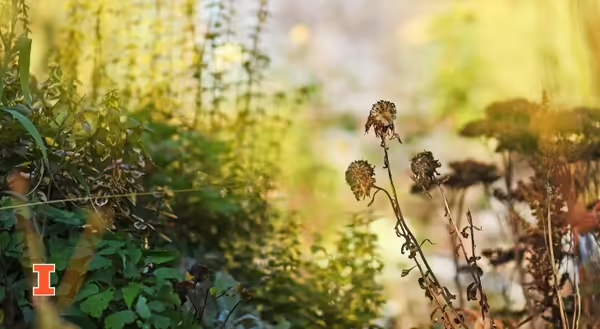
Where did summer go? It seems like we were just enjoying the sun, imagining all the wonderful produce our gardens would make, and looking forward to those lazy days of summer. But suddenly, the kids are back to school and there’s that unmistakable chill in the evening air. It’s time to start thinking about how to wrap our gardens up for the year.
The old way and the new way
Maya Angelou once said, “Do the best you can until you know better. Then when you know better, do better.” In the past, it was recommended to make your yard a blank slate at the end of fall. This way, when spring comes, your yard is ready for planting.
Since the days of the blank slate yard, we’ve learned a few things. Wildlife, such as pollinators, depend heavily on leaf litter and standing stems to survive the winter. Many moth and butterfly species use fallen leaves to blend in so they aren’t scooped up by hungry birds. This is one reason why “leaving the leaves” is so important. Other animals, meanwhile, eat the tasty seeds left on dried flowerheads. Even dead plant matter plays a role in thriving ecosystems our yards are a part of.
The benefits of pollinators
While many of us spent the summer planting gardens and growing flowers for their aesthetic beauty, we also try to keep in mind the benefits for our pollinators, as well. Their role is critical in nature, since they not only help plants to reproduce, but they are also an important part of the food chain. According to researcher Dr. Doug Tallamy, it takes between 6,000 and 9,000 caterpillars to raise a single clutch of chickadee babies. What we do in our gardens in the fall can either help or hinder the next generation of pollinators.
What can we do?
Different groups of pollinators have different strategies for winter survival. Many types of native bees are solitary and do not maintain large hives, like honeybees. They use dry, pithy stems from last year’s plants like elderberry and joe-pye weed to lay their eggs. Ideally the stems should be left standing at the end of the year so that next year’s bees will have a place to lay eggs. If a tidier look is needed, stems can be cut back to between 6-18” tall. These stems will provide homes next summer for bee babies, so they should be left until the end of the following year (i.e. plants cut this fall will be homes for bee eggs during the 2025 growing season and should not be removed until the end of the 2026 growing season, if at all). Bees will thank you for leaving this “stubble” in your garden!
While most people have heard about the monarch migration, that is not the typical winter strategy for moths and butterflies in our area. The majority use leaf litter as winter cover. Whether they spend the winter as an egg, caterpillar, or chrysalis/cocoon, tucking themselves in with the leaves is how they get by. By leaving the leaves whole, we are making sure they are safe through the winter and are ready to go in spring.
About the author: Jamie Viebach is the University of Illinois Extension Horticulture Educator serving DuPage, Kane, and Kendall counties. Viebach’s primary areas of expertise are native plants, landscaping, pollinators, and rain gardens.